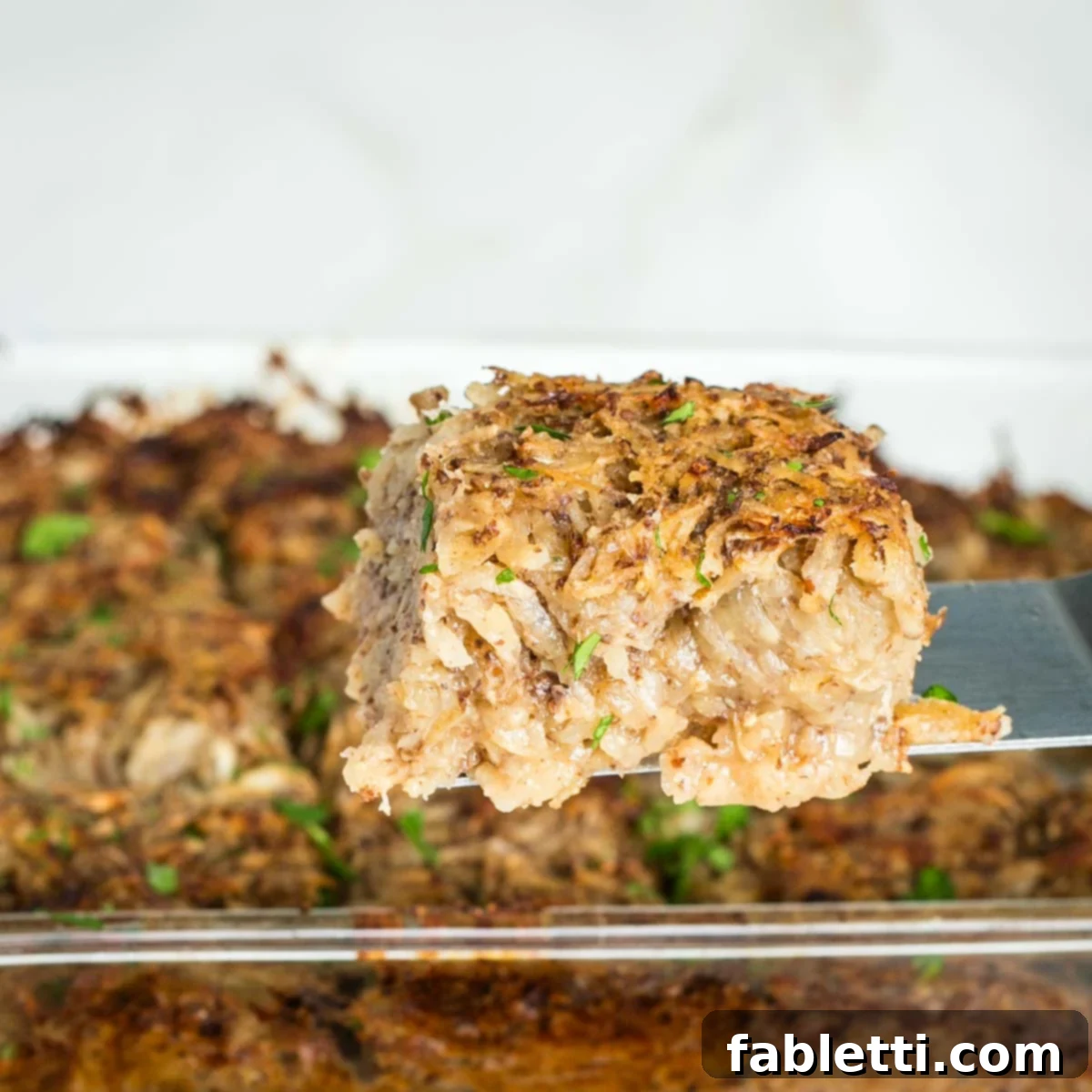Discover the ultimate **Vegan Potato Kugel without Eggs**, a delightful twist on a beloved classic that promises an irresistible crispy exterior and a tender, flavorful interior. This cherished family recipe, originally passed down from my grandmother, has been meticulously adapted to be completely egg-free and dairy-free, making it a perfect savory side dish for anyone with dietary restrictions or those simply seeking a delicious plant-based option. Whether you’re preparing for Rosh Hashanah, Sukkot, Passover, or any Jewish Holiday, this kugel offers a brilliant solution. It uses ground flaxseed as a binder for a vegan celebration, and for Passover, a simple swap to potato starch ensures it remains kosher for the holiday while maintaining that desired crispy perfection.

Having prepared countless kugels and savored an unimaginable amount over the years, I understand the delicate balance required to achieve that ideal texture and taste. While I cherish my recipes for savory cauliflower kugel, a dairy-free sweet noodle kugel, and even individual sweet potato kugel cups that blend savory and sweet notes, the demand for a truly savory, vegan potato kugel without eggs was undeniable. This challenge led me on a journey to perfect a recipe that not only met these requirements but also delivered on the promise of crispiness without a gummy texture, all while using wholesome, real food ingredients.
The path to an eggless kugel that didn’t compromise on texture or flavor was paved with patience and numerous attempts. The breakthrough came from a simple yet crucial technique: finely shredding both the potatoes and onions on the smallest holes of a grater or food processor. This method releases maximum moisture, which is then perfectly absorbed by the ground flaxseed or potato starch, acting as the magical binder that holds the entire savory casserole together. This elegant solution ensures every bite is cohesive, satisfying, and utterly delicious. The simplicity of this approach is truly remarkable, yielding consistently beautiful results every time.
Essential Ingredients for Perfect Vegan Potato Kugel
Crafting the perfect eggless potato kugel relies on selecting the right ingredients and understanding their role in the final texture and flavor. Here’s a closer look at the key components:

- Potatoes: The Foundation of Flavor and Texture
For an ideal kugel, large, starchy baking potatoes like Russet or Idaho varieties are your best bet. Their high starch content is crucial for achieving that desired custardy yet firm consistency, especially when eggs are omitted from the recipe. Unlike waxy potatoes, which tend to become watery and fall apart, starchy potatoes contribute to the structural integrity and rich texture of the kugel. Aim for approximately 3.5 pounds (about 8 medium potatoes) to fill a standard 9×13 inch baking dish generously.
- Binder: The Secret to Cohesion without Eggs
The choice of binder is paramount for an eggless kugel. I’ve found that ground flaxseed (also known as flax meal) works exceptionally well. When combined with the potato and onion “juice,” it creates a mucilaginous mixture that effectively binds the ingredients, preventing a gummy texture and ensuring the kugel holds its shape. This makes it an excellent choice for a vegan kugel, suitable for holidays like Rosh Hashanah and Sukkot. For those observing Passover, potato starch is the perfect substitute. It performs similarly to ground flax, absorbing moisture and providing the necessary structure without being leavened. I strongly advise against using cornstarch or arrowroot powder, as these often result in an undesirably gummy texture that detracts from the kugel’s appeal. Sticking to ground flax or potato starch is key for a truly delicious result.
- Oil: The Golden Touch for Crispiness
Olive oil or avocado oil are excellent choices for this recipe. Oil is not merely an optional addition; it is an absolute necessity if you desire a truly crispy kugel. The generous amount of oil used, especially when heated in the pan before adding the potato mixture, creates those coveted golden-brown, crunchy edges that are often the best part of any kugel. It also adds a layer of rich flavor that complements the earthy potatoes and sweet onions.
- Onion: The Aromatic Heart of the Kugel
Don’t be shy with the onion! If you’re debating between sizes, opt for more rather than less. Shredded onions release a significant amount of “juice” or liquid, which not only infuses the entire kugel with a deep, savory flavor but also contributes to the moisture content that interacts with your chosen binder. This natural sweetness and pungency from the onion are essential for a well-rounded and deeply satisfying taste profile.
- Seasoning: Simple Spices for Maximum Impact
A blend of fine ground sea salt, sweet paprika, and ground black pepper is all you need to elevate the natural flavors of the potatoes and onions. Paprika adds a subtle warmth and beautiful color, while salt and pepper enhance the overall savory notes. Feel free to adjust these to your personal preference, but this basic trio provides a perfect foundation for a classic potato kugel.
Crafting Your Crispy Eggless Potato Kugel: A Step-by-Step Guide
Achieving a wonderfully crispy kugel requires a few crucial steps, particularly the initial heating of the oil in the baking dish. This technique creates those glorious crispy edges that many consider the best part of kugel!
1. Prepare Your Oven and Baking Dish: Begin by preheating your oven to a robust 400 degrees Fahrenheit (200 degrees Celsius). This initial high heat is essential for kickstarting the crisping process. Pour all but one tablespoon of the ⅓ cup olive oil into a 9×13 inch baking dish. Tilt the pan gently back and forth to ensure the oil evenly coats the entire bottom and creeps up the sides. Place this oil-filled dish into the preheated oven while you prepare the potato mixture. The goal is for the oil to be sizzling hot when the potatoes go in.
2. Shred the Onion: Peel two medium yellow onions and cut them into quarters. If you’re using a food processor, ensure the pieces are small enough to fit comfortably into the chute. If grating by hand, simply halve the onions. Using the smallest holes on your grater or the fine shredding disc of your food processor, shred the onions. Don’t worry about the abundance of “juice” that will accumulate; this is perfectly normal and highly desirable for flavor.
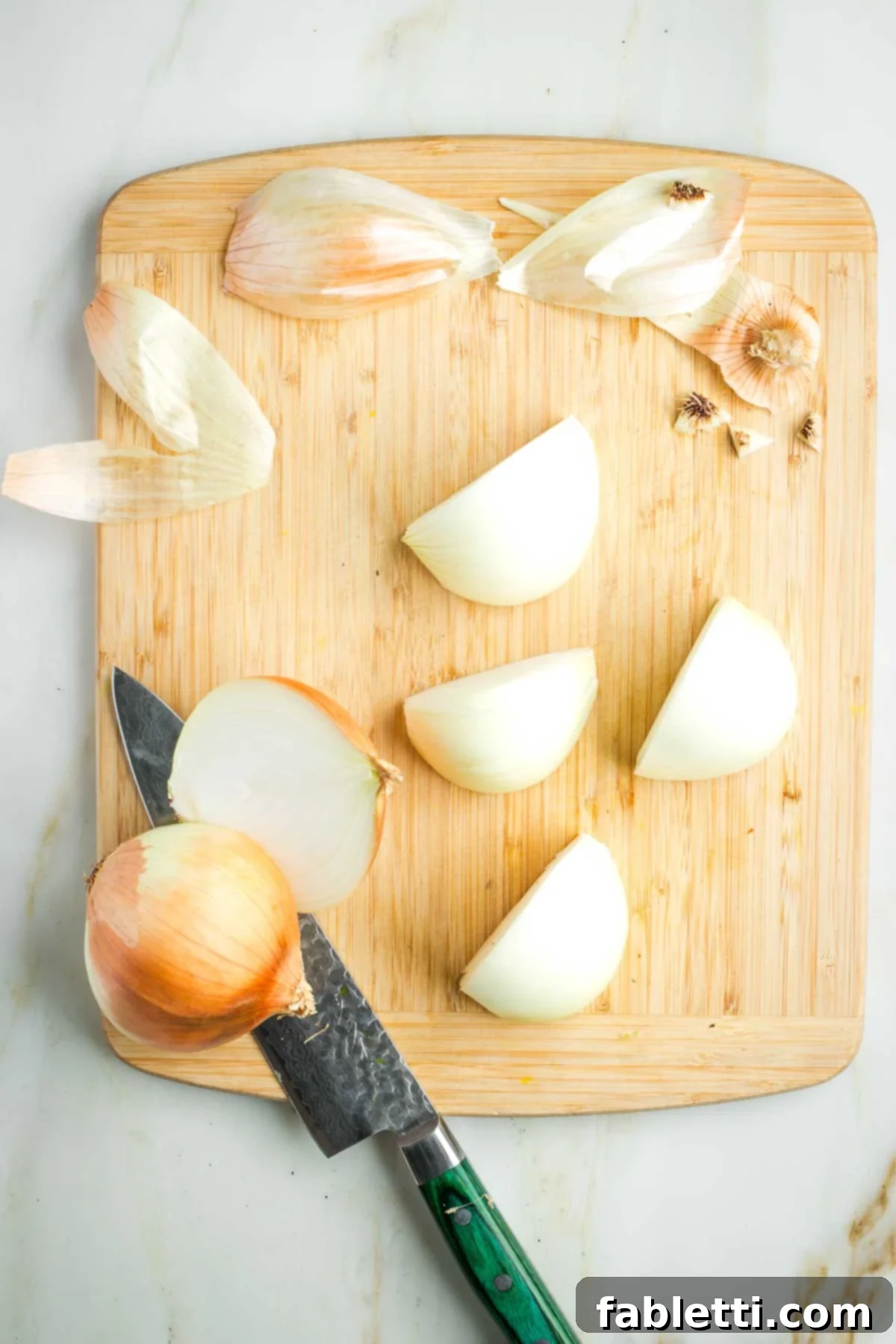
Peel and quarter the onions; adjust size for your shredding tool.
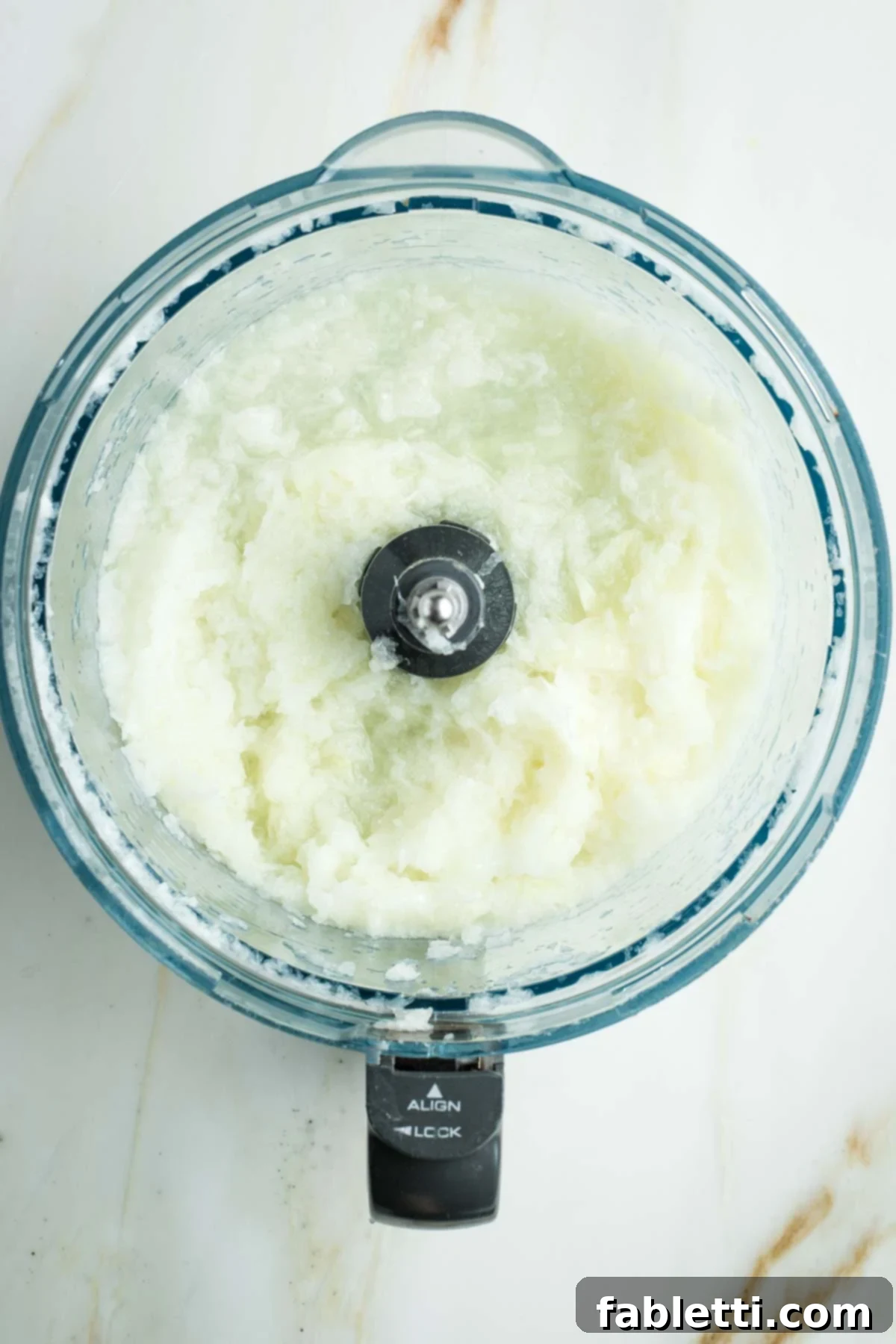
Shred the onion on the smallest holes; the released “juice” is beneficial.
3. Prepare the Potatoes: You do not need to peel the potatoes for this recipe, as the skin adds both flavor and nutrients (just make sure to scrub them very well to remove any dirt or impurities). After scrubbing, cut off any “eyes” or damaged pieces. Pat the potatoes dry with a kitchen towel to remove excess surface moisture. Then, cut them lengthwise into quarters. These pieces should be thin enough to fit easily through the chute of your food processor. If you are grating by hand, leaving the potatoes in larger pieces might offer a more substantial grip, making the process a bit easier.
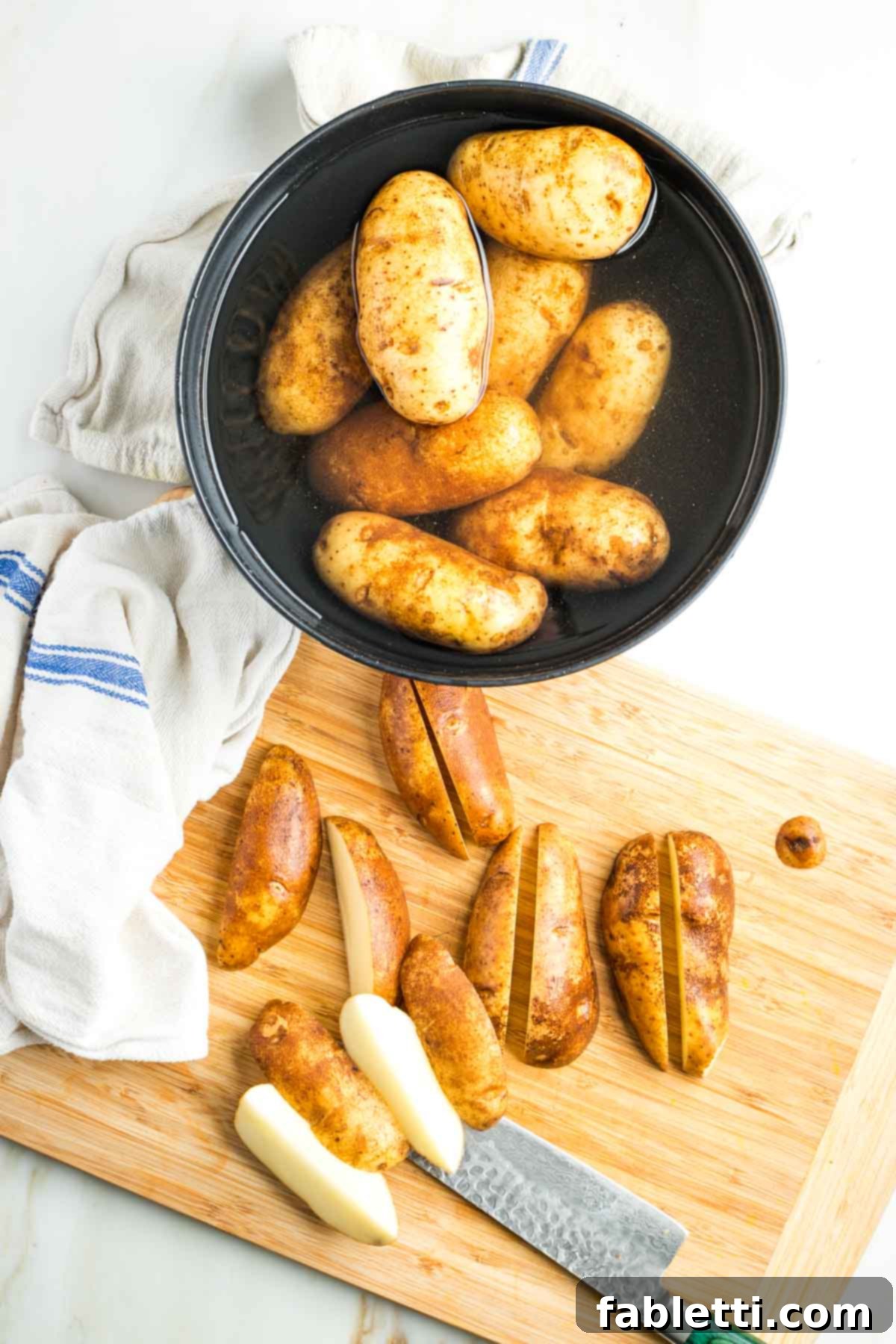
Scrub potatoes clean, remove blemishes, and pat dry.
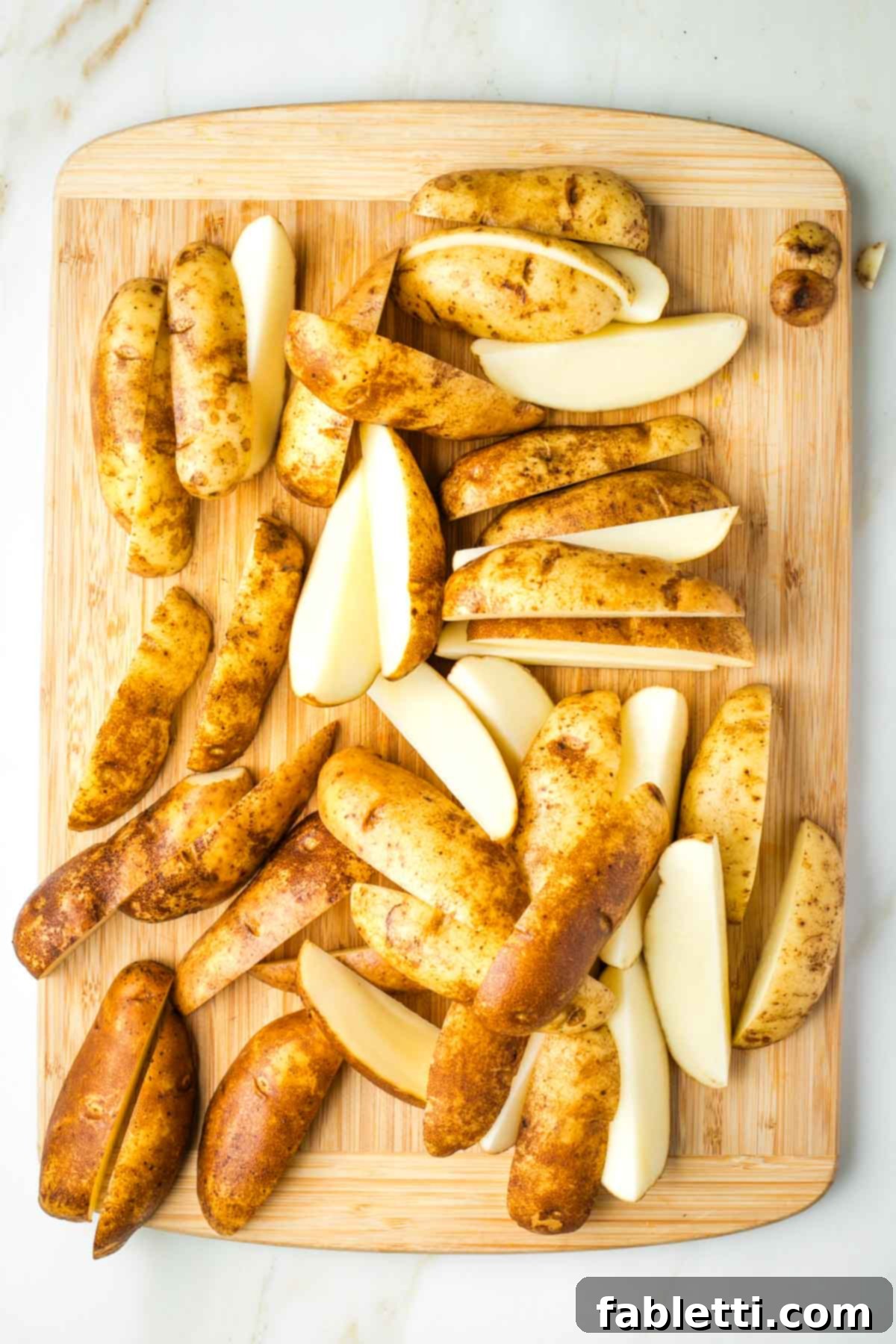
Quarter potatoes lengthwise to fit your food processor or for easier hand grating.
4. Shred the Potatoes: Using the same smallest holes on your grater or the shredding disc of your food processor, shred all the potatoes. Depending on the size of your food processor, you may need to process the potatoes in two or three batches to avoid overcrowding. As you shred, the potato starch will start to release, contributing to the binding properties.
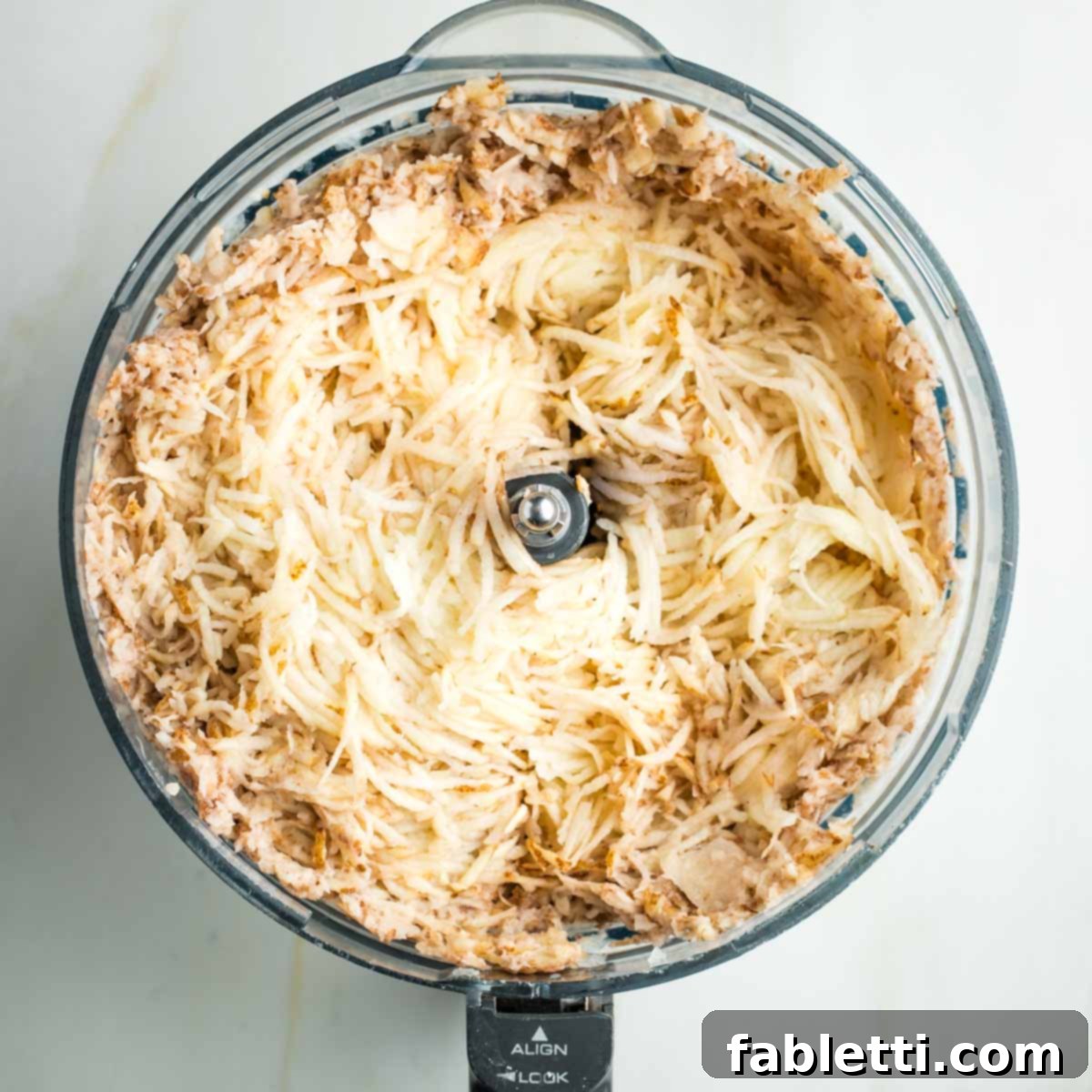
Shred all potatoes, potentially in batches depending on your equipment.
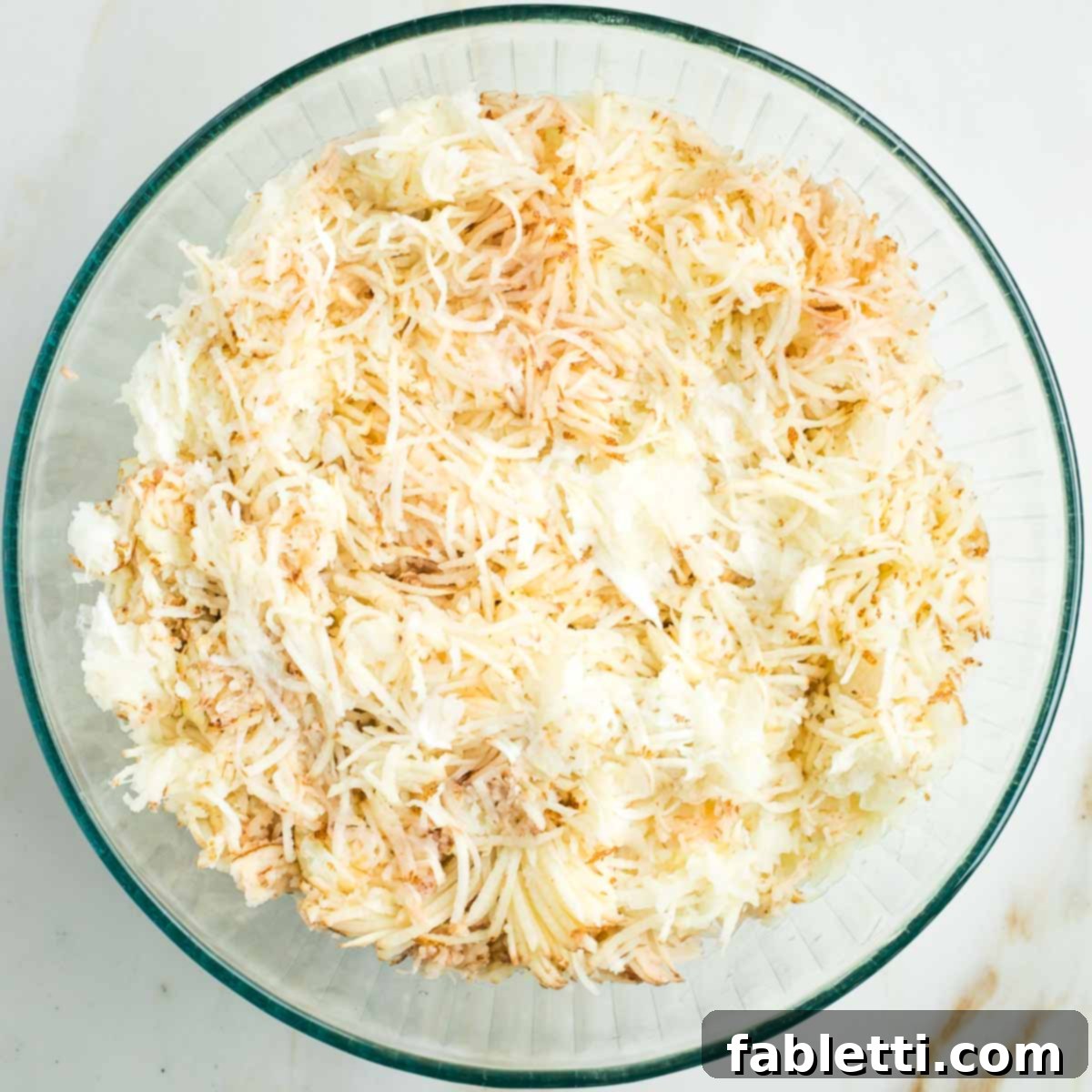
Combine shredded potatoes and onions in a large bowl, ensuring all juices are captured.
5. Season and Mix: Transfer the shredded potatoes and onions into a large mixing bowl, making sure to capture all the flavorful juices. Sprinkle the ground flaxseed (or potato starch), paprika, sea salt, and ground black pepper over the mixture. This is a dense mixture, so mixing thoroughly requires some effort. I find that a sturdy pair of tongs works best to incorporate everything evenly. Alternatively, a large fork or salad tossers can be used. Continue mixing until the paprika is uniformly distributed throughout the mixture; this is your visual cue that all the other spices and the binder are also well-integrated. This even distribution is critical for consistent flavor and binding.
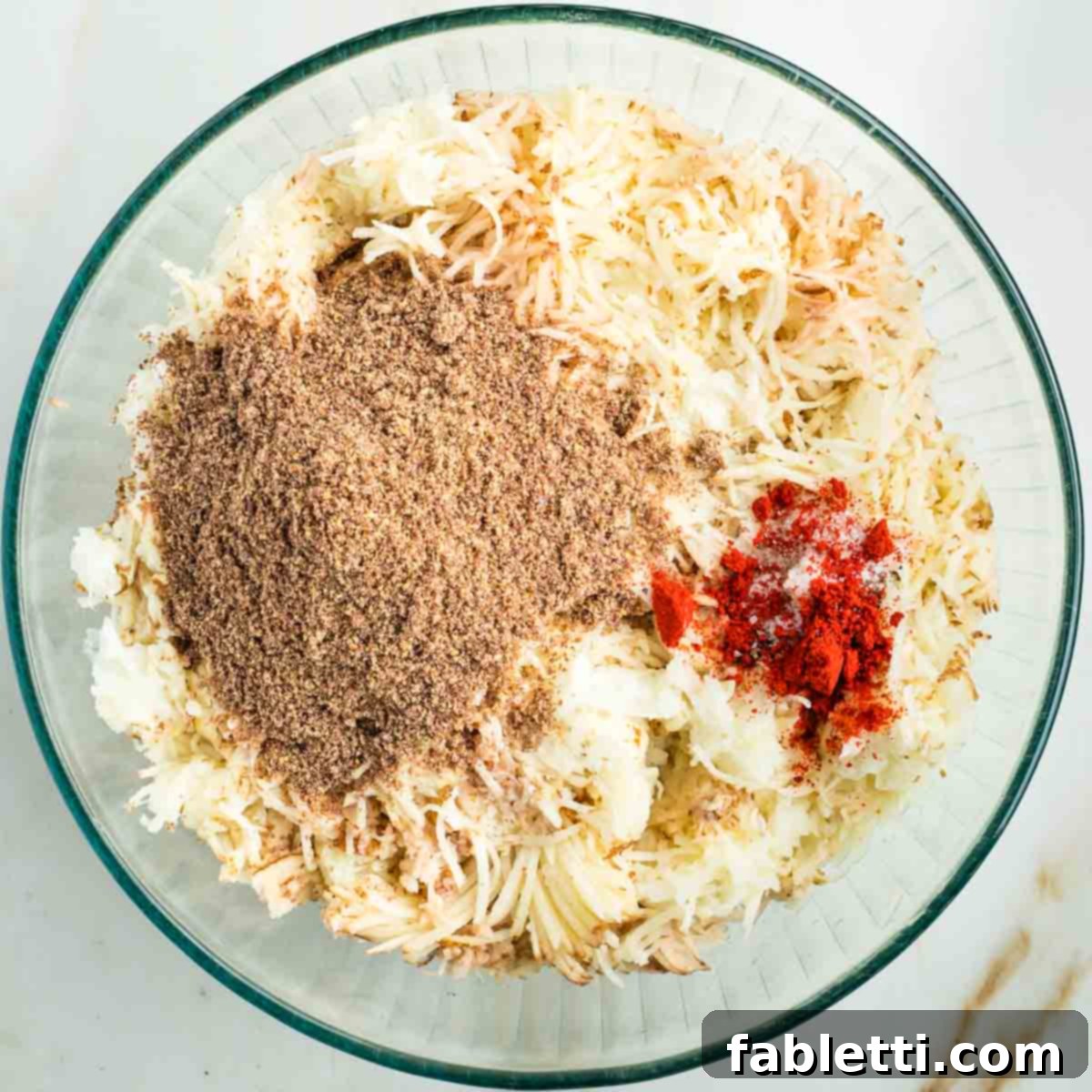
Sprinkle on ground flax or potato starch, paprika, salt, and pepper. Mix thoroughly, scraping up any liquid from the bottom.

Use sturdy tongs or strong hands to ensure all ingredients are well combined.
6. Transfer to Hot Pan and Bake: Carefully remove the piping hot baking pan with the oil from the oven. Immediately transfer the potato and onion mixture into the hot pan. You will hear a satisfying sizzle upon contact, which is exactly what you want—it indicates the formation of that desirable crispy bottom crust. Spread the kugel mixture evenly into all corners and throughout the pan, but avoid pressing it down too firmly; a lighter hand will encourage crispiness. Drizzle the reserved tablespoon of olive oil over the top of the kugel for extra golden goodness, and if you like, a final sprinkle of sea salt.
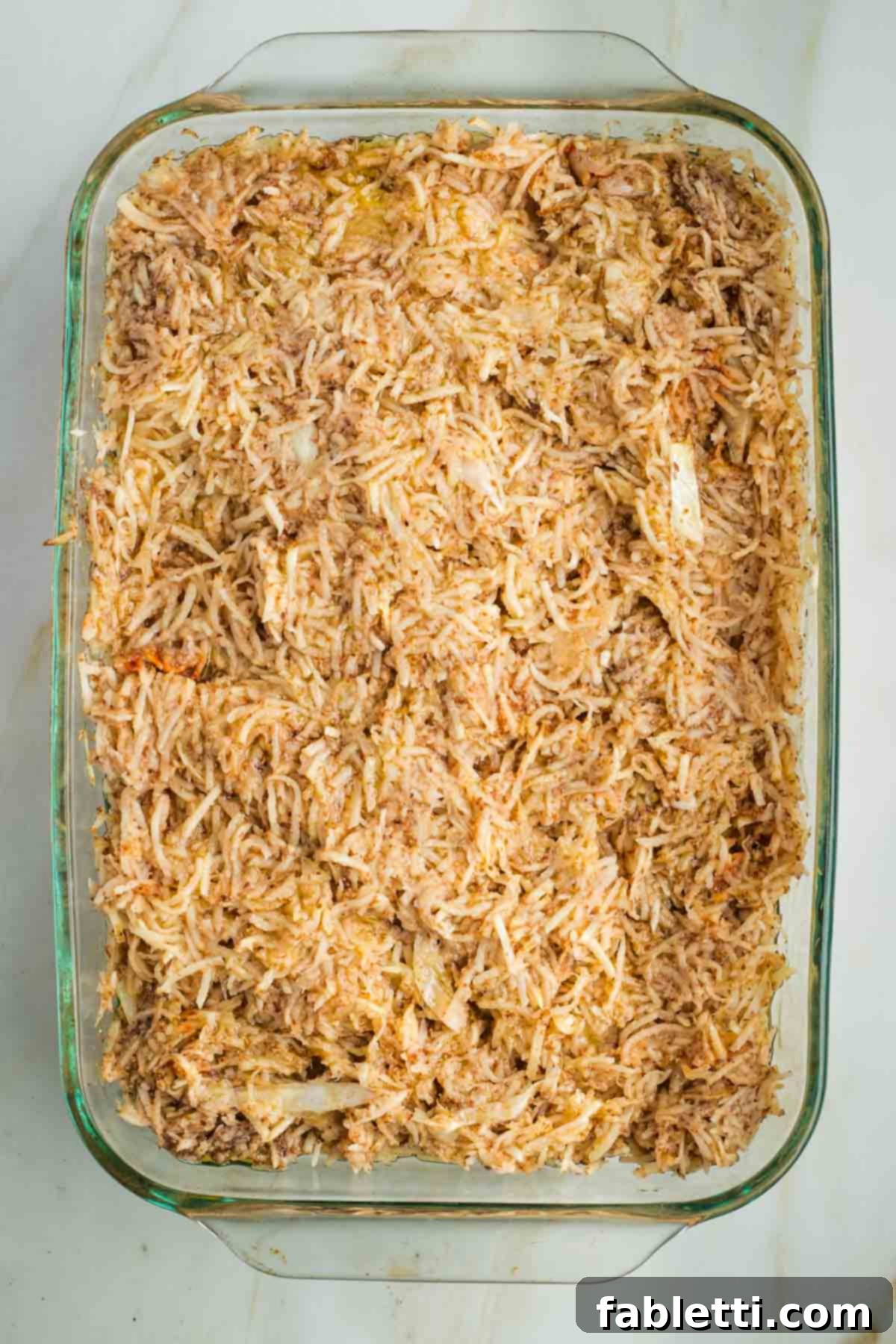
Carefully add the potato mixture to the sizzling hot pan and spread evenly. Drizzle with remaining oil and optional salt.
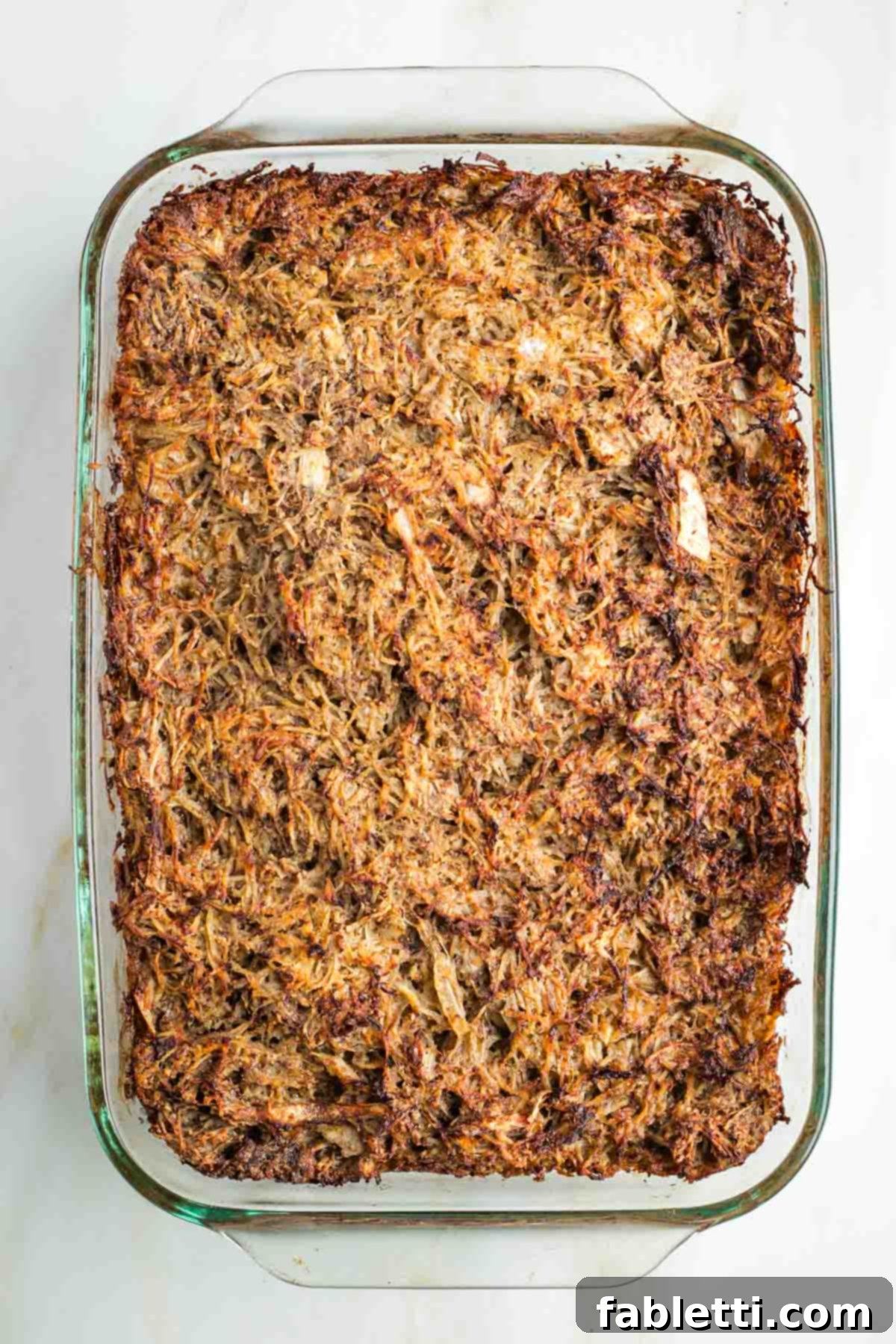
Bake for 90 minutes at 350°F (175°C) until golden brown and firm.
7. Bake to Perfection: Reduce the oven temperature to 350 degrees Fahrenheit (175 degrees Celsius). Bake the kugel for a full 1 hour and 30 minutes. Yes, this duration is indeed necessary! The longer baking time allows the center to cook through completely, while the edges and top achieve that coveted golden-brown, crispy texture. Resist the urge to peek too often, as consistent heat is key. You’ll know it’s ready when the top is deeply golden and firm to the touch.
8. Serve and Enjoy: Once baked, remove the kugel from the oven. Let it rest for a few minutes before slicing it into squares. For an extra touch of color and freshness, sprinkle with some freshly minced herbs like parsley or chives. Serve warm for the absolute best experience, allowing the crispiness and comforting flavors to truly shine. This eggless kugel is a testament to how simple ingredients, when prepared thoughtfully, can create an unforgettable dish.
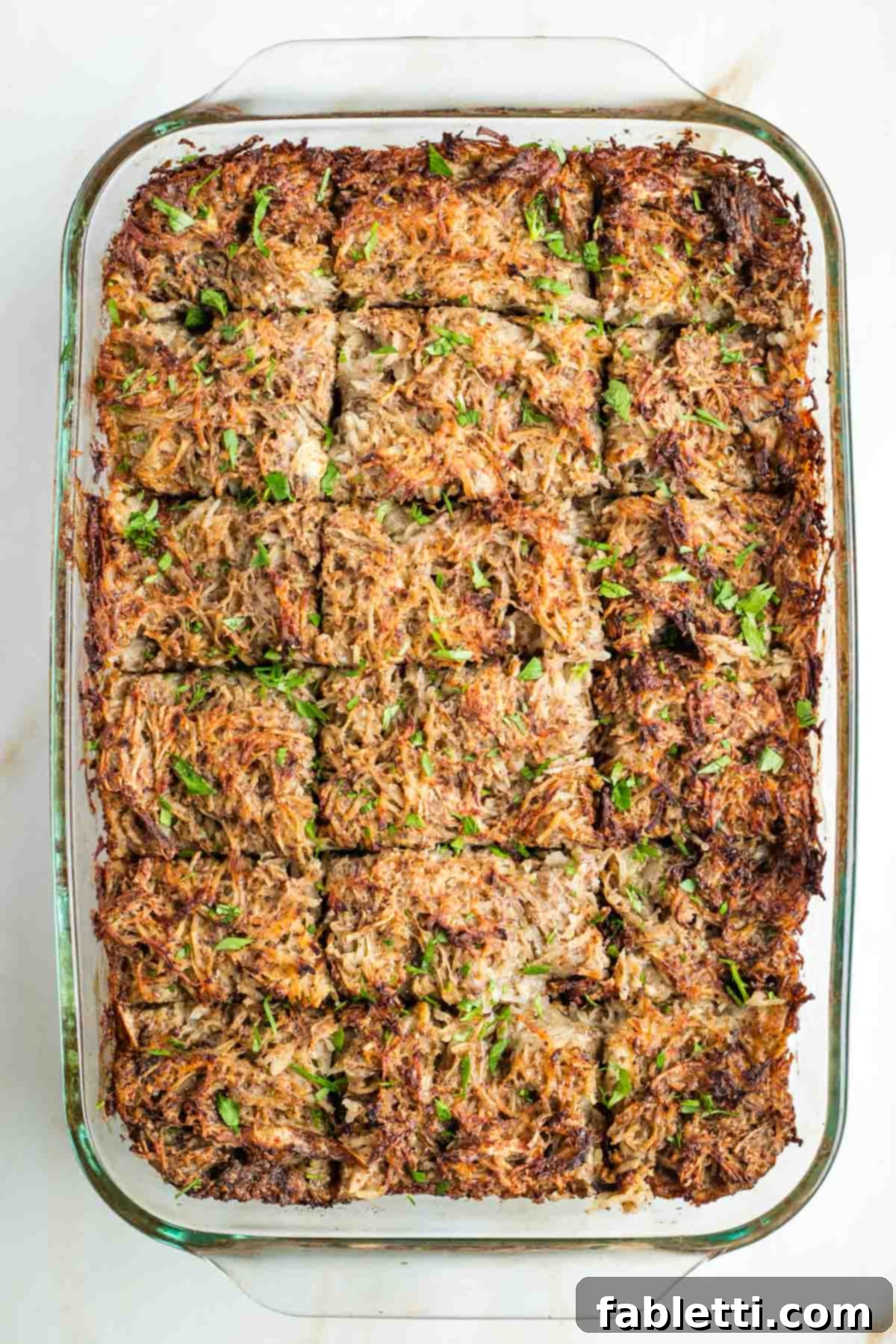
Cut into squares and garnish with fresh herbs for a pop of color.

Serve warm to fully appreciate its texture and flavor.
Debra’s Pro Tips for the Best Kugel
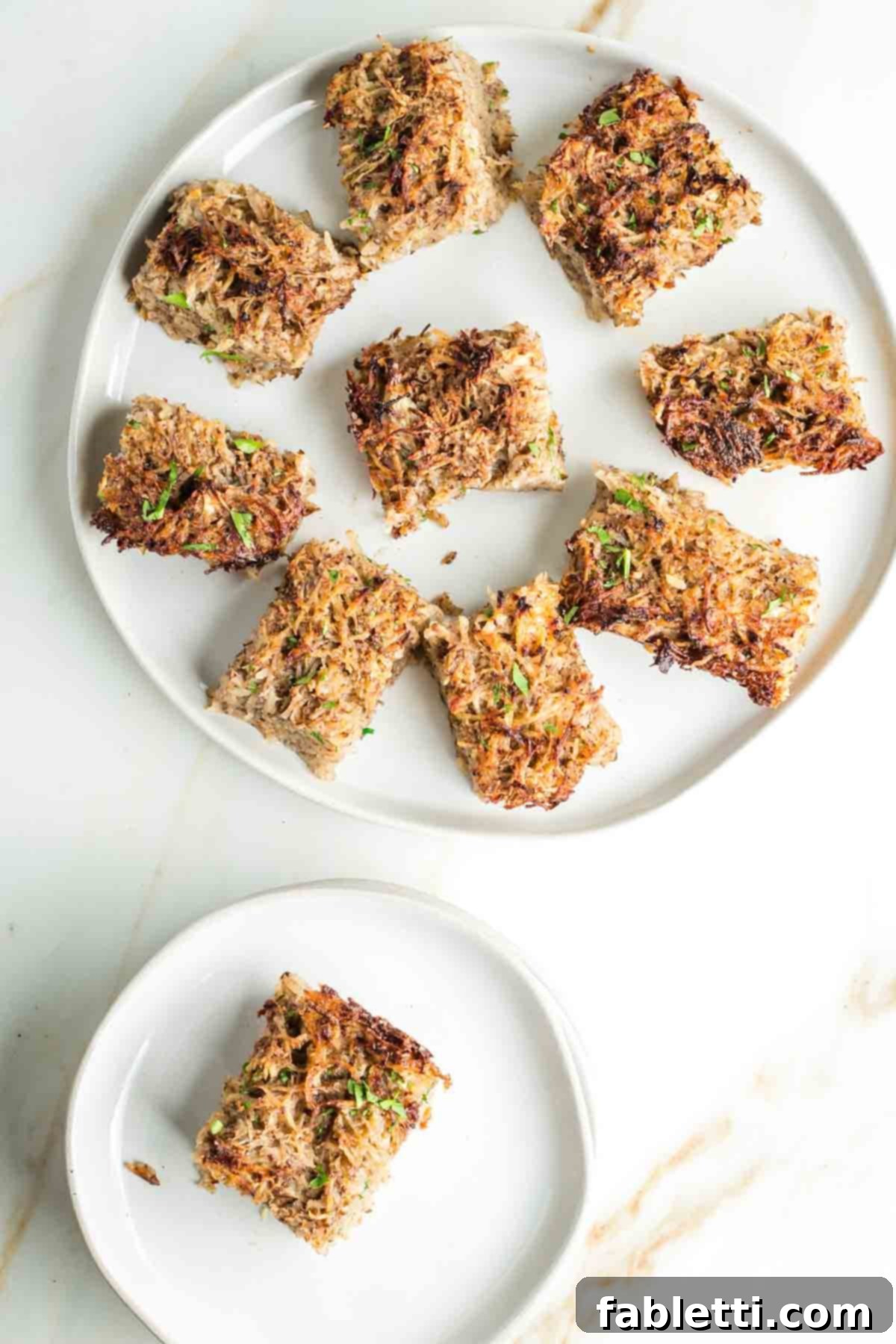
- Embrace the Baking Time: I understand that 90 minutes in the oven sounds like a long time, but truly, the kugel bakes mostly unattended, requiring minimal active participation. This extended baking period is essential for the center to cook completely and to develop that deeply golden, crispy crust all around. If you’re pressed for time or prefer even more crispy surface area, consider dividing the mixture between a 9×13 inch pan and an 8×8 inch pan. This creates a thinner kugel that will cook more quickly, likely in about an hour, and maximizes those desirable crispy edges.
- The Power of Fresh Herbs: Never underestimate how a simple sprinkle of fresh herbs can transform the appearance of any dish, especially hearty, beige-toned foods like kugel. Finely minced fresh parsley, chives, or even dill can add a vibrant pop of color and a burst of fresh flavor, making your kugel even more appealing.
- Make Ahead and Reheat with Ease: This vegan potato kugel is excellent for make-ahead meal planning. Once baked and completely cooled, cover it tightly and store it in the refrigerator for up to 5 days. To reheat and restore its crispiness, place it in a 375°F (190°C) oven for about 20 minutes, or until heated through and the top is re-crisped. For smaller portions, reheating in a hot cast-iron skillet on the stovetop can also revive its delightful crunch.
- Freezing for Future Feasts: While you can freeze kugel for up to three months, be aware that the texture may change slightly upon thawing. It might become a little softer than freshly baked. To freeze, allow the kugel to cool completely, then wrap it tightly in plastic wrap and then in foil. Defrost it in the refrigerator overnight before reheating in a 375°F (190°C) oven as described above.
- Beyond the Holidays: While this eggless potato kugel is a staple for Rosh Hashanah, Sukkot, Hanukkah, and Passover, its comforting and versatile nature makes it suitable for any occasion. Serve it as a delicious breakfast hash at brunch, a hearty side dish for weeknight dinners, or a standout offering at potlucks and gatherings. Its savory profile pairs wonderfully with roasted vegetables, plant-based roasts, or even a simple fresh salad.
Your feedback is invaluable! Commenting and rating recipes are fantastic ways to support your favorite food bloggers. If you’ve made this delicious Vegan Potato Kugel without Eggs, please consider leaving a five-star rating and a comment below to share your experience. We also encourage you to share your beautiful photos on Instagram by tagging @dkhealthcoach and using the hashtag #debraklein. We can’t wait to see your creations!
📖 Vegan Potato Kugel without Eggs Recipe
This savory vegan potato kugel delivers incredible crispiness on the outside and a wonderfully tender, flavorful interior, all without a single egg! It’s the perfect side dish for Passover, Rosh Hashanah, Sukkot, Hanukkah, and any Jewish Holiday, or simply whenever you crave a comforting, plant-based potato dish.
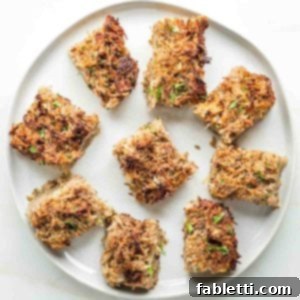
Recipe Details
- Author: Debra Klein
- Summary: Vegan potato kugel that’s crispy outside, tender inside, and completely egg-free! Ideal for Jewish Holidays.
- Course: Side Dish
- Cuisine: Jewish Holiday
- Servings: 18
- Calories: 152 kcal per serving
- Prep Time: 10 minutes
- Cook Time: 1 hour 30 minutes
- Total Time: 1 hour 40 minutes
Equipment
- Food Processor (recommended for efficiency)
- Box Grater (alternative for hand shredding)
- 9×13 inch Baking Dish
- OXO Good Grips 12-Inch Stainless-Steel Locking Tongs
Ingredients
- ⅓ cup olive oil, divided
- 2 medium yellow onions
- 3.5 lbs Russet or Idaho potatoes (approximately 8 medium-sized)
- ⅔ cup ground flax or potato starch (use flax for vegan, potato starch for Passover)
- 1.5 teaspoon fine ground sea salt
- 1.5 teaspoon sweet paprika
- 1 teaspoon ground black pepper
Instructions
- Preheat your oven to 400°F (200°C). Pour all but 1 tablespoon of the olive oil into a 9×13 inch baking pan. Place the pan in the preheated oven while you prepare the potato mixture. Reserve the remaining tablespoon of olive oil to drizzle over the kugel before baking.
- Using the smallest holes of a shredding disc on your food processor or the fine side of a box grater, shred the onions.
- Scrub the potatoes thoroughly to remove any dirt; peeling is not necessary. Cut the potatoes lengthwise into quarters so they fit easily into your food processor chute. If grating by hand, you may find it easier to grate them whole, starting from the smaller end, for better grip.
- Combine the shredded onions and potatoes in a large bowl, ensuring all their natural juices are collected. Sprinkle the ground flaxseed (or potato starch), salt, pepper, and paprika over the mixture.
- Mix the dense potato mixture thoroughly. A large pair of tongs is recommended for ease, otherwise use a sturdy fork or large salad tossers. Continue mixing until the paprika is visibly evenly dispersed throughout the mixture, indicating that all ingredients are well combined.
- Carefully remove the hot pan with oil from the oven. Transfer the potato mixture into the pan; it will sizzle upon contact, which is ideal for creating a crispy bottom. Spread the kugel evenly into all corners of the pan, but do not press down too firmly. Drizzle the reserved tablespoon of olive oil over the top.
- Reduce the oven temperature to 350°F (175°C). Bake for 1 hour and 30 minutes. The kugel will develop a beautiful golden top and crispy edges, and the center will be firm and cooked through.
- Remove from oven, slice into squares, and serve warm. For pre-made kugel, reheat in a 375°F (190°C) oven for approximately 20 minutes, or until the top is re-crisped and heated throughout.
Notes
To store: Allow the kugel to cool completely before transferring it to an airtight container. It can be stored in the refrigerator for up to 5 days. While it can be frozen for up to three months, please note that the texture might become slightly softer upon thawing. If freezing, defrost in the refrigerator overnight before reheating in a 375°F (190°C) oven for 20 minutes.
Nutrition (per serving, approximately)
Calories: 152 kcal | Carbohydrates: 21g | Protein: 3g | Fat: 7g | Saturated Fat: 1g | Polyunsaturated Fat: 2g | Monounsaturated Fat: 3g | Sodium: 137mg | Potassium: 490mg | Fiber: 3g | Sugar: 1g | Vitamin A: 56IU | Vitamin C: 7mg | Calcium: 32mg | Iron: 1mg
Note: The nutrition calculations provided are estimations generated using online tools. For the most accurate nutritional information, it is recommended to calculate based on the specific ingredients and brands you use. You are ultimately responsible for verifying the accuracy, completeness, and usefulness of any nutritional data.
Did you make this recipe? We’d love to see it! Please leave a review below, then snap a picture and tag @dkhealthcoach or use the hashtag #dkhealtcoach on Instagram!

